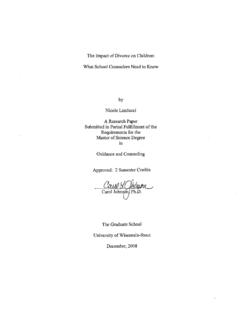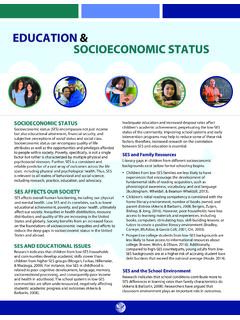Transcription of Socioeconomic Status and Its Effect on Teacher/Parental ...
1 Journal of Education and Learning; Vol. 5, No. 1; 2016. ISSN 1927-5250 E-ISSN 1927-5269. Published by Canadian Center of Science and Education Socioeconomic Status and Its Effect on Teacher/Parental Communication in Schools Raymond J Ankrum1. 1. Northeastern University, Boston, MA, USA. Correspondence: Raymond J Ankrum, Northeastern University, Boston, MA, USA. E-mail: Received: January 1, 2016 Accepted: January 18, 2016 Online Published: January 21, 2016. URL: Abstract The power of communication and community engagement utilized by teachers to actively involve parents and guardians in the educational process of their children is essential to the growth of the students. An important component to student motivation is a teacher's ability to leverage parental/guardian relationships.
2 A teacher's ability to form partnerships with parents to help motivate student achievement is an unmeasurable intangible. Teacher interactions with parents /guardians can make or break the student's relationships with the teachers. Teachers should think of parents as thought-partners in providing rigorous, meaningful education to students. parents should think of teachers as extended family to students. The partnership between parent and teacher should bridge the gap in the child's education. Extraneous factors such as the Socio-economic Status of families should never play a role in how teachers communicate with parents . Keywords: Socioeconomic Status , teacher communication, critical communication pedagogy 1. Introduction Nobel laureate James Heckman, drawing on his own studies and the work of others, has written extensively about gaps between socioeconomically disadvantaged and advantaged students in both cognitive skills and what he calls non-cognitive or soft skills traits that include motivation, the ability to work with others, the ability to focus on tasks, self-regulation, self-esteem, and the ability to defer gratification (Heckman, 2011).
3 Indeed, he maintains, these soft skills are critical to success in school and later life, and their importance is often underrated (Heckman, 2008). Heckman notes that family factors can influence children from as early as when they are in the womb. By the time they enter school, children from socioeconomically disadvantaged families possess lower levels of cognitive and non-cognitive skills and lag far behind their more advantaged peers. Even worse, these gaps have been shown to persist as children age (Heckman, 2008, 2011). Moreover, a child's capability to succeed in school depends on how successfully the child is managed by his/her parents in the home environment. It is an environment where the child learns the skills, attitudes and behavior which could mold them into a productive and successful student.
4 However, not every child comes from a home that could provide them with the requisite educational resources necessary for their academic success. In accordance with that, a parent's Socioeconomic Status plays an important role in providing these educational resources and it appears to impose the greatest impact on the child's educational outcomes (Vellymalay, 2012a). 2. Literature Review Research in parent involvement, (Midraj & Midraj, 2011) shows that involvement at home has a more significant impact on children's attainment than parent involvement in school activities. Kingsley (2011) carried out a study to analyze the link between parental school involvement and the academic achievement of young students from diverse socio-economic backgrounds between the ages of (15 and 20), the results indicate a positive and significant correlation between mothers' school involvement and the academic achievement of the students.
5 Howe and Simmons (2005) stated that communication needs to occur regularly and frequently between the teachers and parents about the child in their care. Jeynes (2003) found that parent involvement ( , communicating with the school, checking homework, encouraging outside reading and participating in school activities) benefited African-Americans and Hispanic/Latinos more than it did Asian Americans. Epstein (2005) contended that data from parents in the most economically depressed communities does not support the idea that poor families do not have the same goals as middle class families . Furthermore, it was 167. Journal of Education and Learning Vol. 5, No. 1; 2016. determined that if schools took on parental involvement as a serious part of the organization and ensure that all parents have opportunities for involvement, then social class and parents ' level of education decrease or disappear as important factors.
6 Numerous studies with samples differing in ethnicity and income have demonstrated that both of these dimensions of the home-school mesosystem are associated with student academic engagement and achievement (Boethel, 2003). For example, Rimm-Kaufman et al. (2005) found that kindergarten teachers' reports of parents ' attitudes toward education predicted child participation and engagement after accounting for SES and maternal sensitivity. Ronald Ferguson's researched based tips for high-achievement parenting suggests that parents promote reading at home, discuss reading materials with their children in ways that encourage children to enjoy learning, and seek opportunities at home to discuss and apply what children are learning in school, among other activities.
7 Ferguson further recommends that parents set clear and firm rules about homework, television watching, and other daily activities, and that they actively seek out-of-school opportunities and extracurricular activities that reinforce school lessons, and encourage exploration and creativity, and develop children's special talents (Ferguson, 2007a). Other scholars maintain that social context can lead some children to perceive that certain types of behavior, such as spending time on homework, are pointless and not for people like me if they form their identity in a context that provides no example of how academic achievement might be relevant to their personal goals (Oyserman &. Destin, 2010, p. 1002). As Tamera Murdock explains, categories whether racial, ethnic, gender or other help students define who they are and construct a vision of who they might become.
8 Contexts in which students are able to view academic achievement as a realistic aspect of their group identity and develop positive images of that identity can foster motivation (Murdock, 2009, p. 451). In the article Investigating Parental Involvement by DeTorres (2010), the author elicited research to support the claim that parents that are involved, and better equipped to accommodate their students to experience success in school. The United States government is familiar with the benefits of parental involvement for students and has made multiple efforts to push for more parent involvement in the school systems (Abdul-Adil & Farmer, 2006). The effects of these acts can be seen in many School Improvement Plans (SIPs). The last goal in the Piney Point Elementary School (PPES) SIP is that they want increased communication, collaboration, and partnerships with all stakeholders , and parents are listed as one of the stakeholders (Piney Point Elementary School Improvement Plan, 2008, p.)
9 28). Low SES families are often working all of the time to take care of their families , and they have no time to participate in their child's education on campus (Ratcliff & Hunt, 2009). Based on a study involving low SES. mothers, mothers want to be involved in their child's education, but the other problem is that they are less comfortable around teachers, and so they do not get involved (Machen, Wilson, & Notar, 2005). Turney and Kao (2009) found in their research that Hispanic and Asian parents who were not born in the USA were almost three times more likely to feel unwelcome at their children's school than white Americans. African American parents face more obstacles, including safety and travel issues, and not feeling welcome, than any other group born in the USA (Turney & Kao, 2009).
10 In a study where community members knew that their community was characterized by lower SES families and knew of the difficulties that lower SES families face, the community still viewed low SES parents who were not involved on school grounds negatively (Taliaferro et al., 2009). As for schools located in low SES communities, they are less likely to invite parents to be involved at school (Van Velsor & Orozco, 2007). In the classroom Latino parents do not understand the expectations of their involvement, and teachers might not begin to contact the parents to get them involved until late in the year (Desimone, 1999). Low amounts of teacher-initiated contact are partially due to the fact that low income immigrant parents are often viewed [by teachers] as being indifferent to their children's schooling (Orozco, 2008, p.)
















